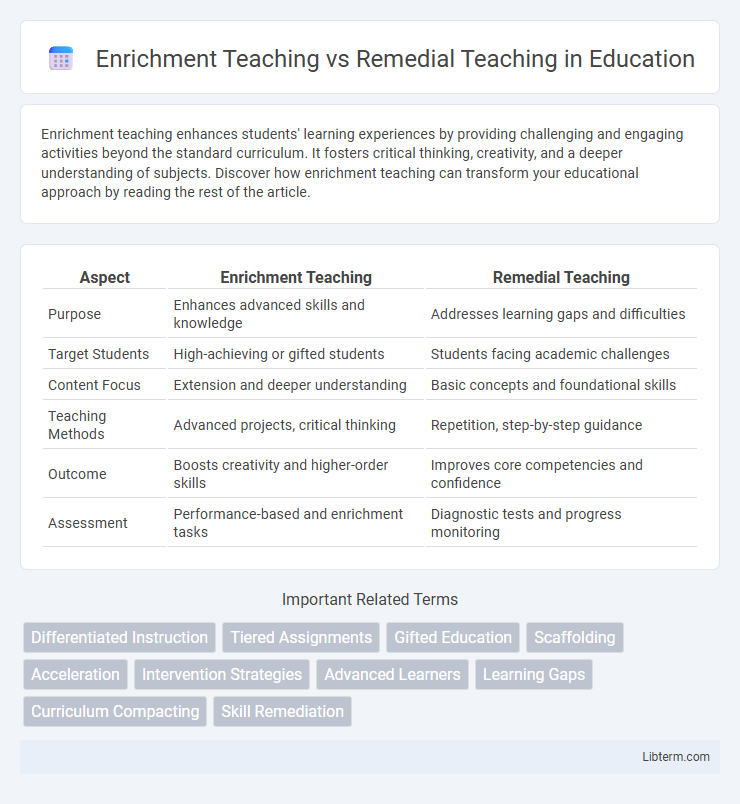Enrichment teaching enhances students' learning experiences by providing challenging and engaging activities beyond the standard curriculum. It fosters critical thinking, creativity, and a deeper understanding of subjects. Discover how enrichment teaching can transform your educational approach by reading the rest of the article.
Table of Comparison
| Aspect | Enrichment Teaching | Remedial Teaching |
|---|---|---|
| Purpose | Enhances advanced skills and knowledge | Addresses learning gaps and difficulties |
| Target Students | High-achieving or gifted students | Students facing academic challenges |
| Content Focus | Extension and deeper understanding | Basic concepts and foundational skills |
| Teaching Methods | Advanced projects, critical thinking | Repetition, step-by-step guidance |
| Outcome | Boosts creativity and higher-order skills | Improves core competencies and confidence |
| Assessment | Performance-based and enrichment tasks | Diagnostic tests and progress monitoring |
Introduction to Enrichment and Remedial Teaching
Enrichment teaching enhances students' existing knowledge by offering advanced content that promotes critical thinking and creativity, catering to high-achieving learners. Remedial teaching targets students struggling with foundational skills, providing tailored support to bridge learning gaps and achieve grade-level proficiency. Both methods employ specialized strategies to address diverse educational needs, optimizing student success through differentiated instruction.
Defining Enrichment Teaching
Enrichment teaching involves providing advanced learning opportunities that challenge students beyond the standard curriculum, fostering critical thinking and creativity. It emphasizes depth and complexity in subject matter, enabling learners to explore concepts in greater detail and develop higher-order skills. Unlike remedial teaching, which addresses learning gaps, enrichment aims to enhance and extend knowledge for students already performing at or above grade level.
Understanding Remedial Teaching
Remedial teaching targets students who struggle with foundational concepts, aiming to close learning gaps through tailored instruction and repetitive practice. It emphasizes diagnosing specific academic weaknesses, using targeted interventions to build skills and confidence, thereby improving overall performance. This approach contrasts with enrichment teaching, which extends learning for advanced students beyond standard curricula.
Key Objectives of Enrichment Teaching
Enrichment teaching aims to deepen students' understanding and foster higher-order thinking skills beyond the standard curriculum by providing challenging and stimulating activities. Its key objectives include enhancing creativity, critical thinking, and intellectual curiosity while promoting independent learning and problem-solving abilities. This approach supports gifted and advanced learners in reaching their full potential through specialized content and exploratory learning experiences.
Core Goals of Remedial Teaching
Remedial teaching primarily aims to bridge learning gaps by reinforcing foundational skills in reading, writing, and mathematics to ensure students meet grade-level competencies. It targets students struggling with specific concepts, offering personalized instruction to boost confidence and academic performance. This approach focuses on diagnosing weaknesses and implementing tailored strategies to remediate deficiencies efficiently.
Target Learner Groups for Both Approaches
Enrichment teaching targets advanced or gifted learners who require deeper challenges and extended learning opportunities beyond the standard curriculum to foster higher-order thinking skills. Remedial teaching focuses on students struggling with foundational skills, aiming to close learning gaps and build essential competencies for grade-level mastery. Both approaches tailor instructional strategies to meet the distinct needs of their respective learner groups, optimizing educational outcomes through differentiated support.
Instructional Strategies in Enrichment Teaching
Enrichment teaching employs advanced instructional strategies such as differentiated instruction, project-based learning, and critical thinking exercises to challenge high-achieving students beyond the standard curriculum. Strategies include using open-ended questions, fostering independent research skills, and integrating interdisciplinary content to deepen understanding and creativity. These approaches promote cognitive growth by encouraging exploration and problem-solving at higher complexity levels compared to remedial teaching, which focuses on foundational skill reinforcement.
Methods and Techniques in Remedial Teaching
Remedial teaching employs targeted diagnostic assessments to identify specific learning gaps, enabling personalized instruction tailored to individual student needs. Techniques such as multisensory learning, repetitive practice, and scaffolded support help reinforce foundational skills and build confidence. Methods also include small group interventions, one-on-one tutoring, and the use of assistive technology to address diverse learning difficulties effectively.
Benefits and Challenges of Each Approach
Enrichment teaching enhances students' learning experiences by promoting critical thinking, creativity, and advanced skills, benefiting high-achievers and gifted learners; however, it challenges educators to design engaging, differentiated content that maintains motivation without overwhelming students. Remedial teaching focuses on addressing knowledge gaps and skill deficits to bring struggling learners up to grade level, offering targeted support that improves foundational understanding, yet presents difficulties in balancing pace and content to avoid stigma and sustain student confidence. Both approaches require tailored assessment methods and resource allocation to maximize educational outcomes while managing diverse learner needs effectively.
Choosing the Right Approach for Diverse Learners
Enrichment teaching enhances advanced learners by providing challenging materials that expand skills and encourage critical thinking, while remedial teaching focuses on closing learning gaps for students who struggle with foundational concepts. Selecting the right approach requires assessing individual student needs to balance skill advancement and skill reinforcement effectively. Tailoring instruction ensures diverse learners receive personalized support that fosters growth and confidence across varying proficiency levels.
Enrichment Teaching Infographic

 libterm.com
libterm.com